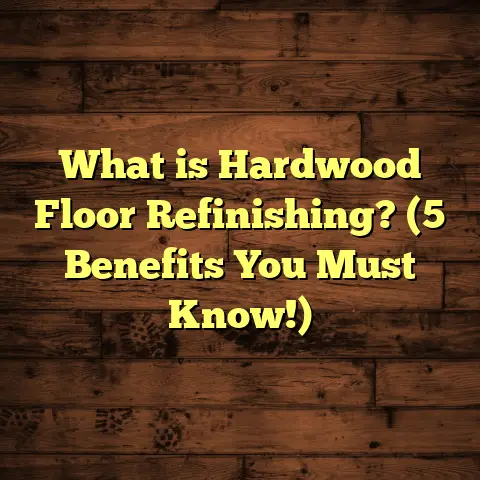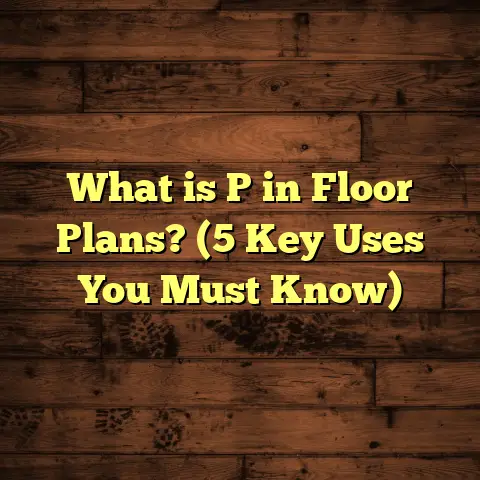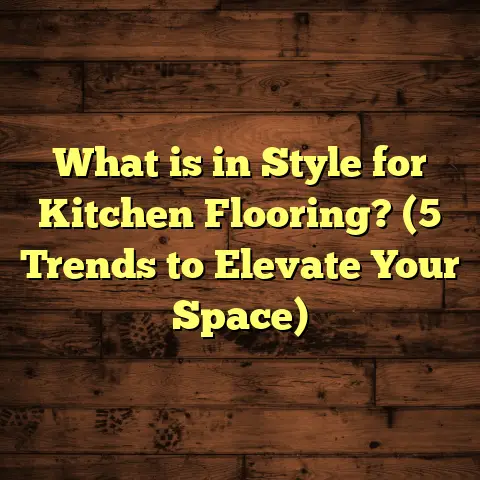What is WPC Flooring? (5 Reasons It’s the Best Choice!)
Long-term savings have always been a major factor for me when picking flooring for my home or clients’ projects. I’ve learned the hard way that the cheapest upfront cost doesn’t always pay off in the long run. Flooring that lasts longer, requires less maintenance, and resists damage can save thousands over decades. That’s why I’m excited to share my thoughts on WPC flooring, something I’ve worked with on many jobs and personally installed in my own house. It’s a flooring option that delivers durability, style, and real value over time.
What is WPC Flooring?
WPC stands for Wood Plastic Composite. But what does that mean exactly? It’s a type of engineered flooring made by combining wood fibers or sawdust with plastic polymers. The result is a dense, rigid core that’s waterproof and stable. This core forms the base or “heart” of the plank.
On top of this core sits a printed vinyl layer designed to mimic natural materials like hardwood, stone, or tile. This layer is covered by a transparent wear layer that protects against scratches, stains, and everyday wear.
This layered construction sets WPC apart from traditional hardwood and laminate flooring. Hardwood is solid wood and can warp, swell, or scratch easily. Laminate uses a fiberboard core that can swell badly if exposed to water. WPC’s plastic component makes it far more resistant to moisture and impacts.
The plastic used in WPC is often a combination of PVC or other polymers mixed with wood flour (fine wood particles). This blend gives it strength, flexibility, and resistance to water — something pure wood can’t match.
Why I Believe WPC Flooring Is the Best Choice: 5 Reasons
1. Water Resistance That Surprised Me
I’ll never forget the first time I saw WPC flooring hold up against a serious water spill. I was working on a kitchen remodel where the client had two young kids who frequently spilled drinks. After multiple accidents, most floors would begin to swell or stain.
But the WPC planks? They stayed perfectly intact with no warping or bubbling.
This isn’t just anecdotal. Research shows that WPC flooring can resist water penetration for hours without damage. In fact, some brands advertise their products as fully waterproof, meaning standing water won’t ruin them.
Contrast that with traditional laminate floors which can start swelling within minutes of water exposure. Hardwood is even worse — water causes it to expand and warp quickly.
For rooms with moisture risks—kitchens, bathrooms, basements—WPC offers peace of mind that other wood-based floors can’t match.
2. Durability That Lasts
Some years ago, I installed hardwood floors in a rental property only to see them dented and scratched within months from tenants’ heavy use. This experience taught me to prioritize durability in my flooring choices.
WPC has proven to be remarkably tough. Its composite core absorbs impacts better than plain wood or laminate fiberboard.
The wear layer on top protects against scratches from pets’ claws, furniture movement, and everyday scuffs.
According to data from manufacturers, high-quality WPC planks often feature wear layers between 0.3 mm and 0.7 mm thick. This translates to a lifespan of 15-25 years under normal residential conditions.
Even commercial-grade WPC floors have demonstrated impressive durability in retail stores and offices where foot traffic is heavy daily.
So if longevity matters to you—whether for family homes or business spaces—WPC flooring can be a wise investment.
3. Easy Installation That Saved Me Time and Money
One thing I’ve learned from many projects is how installation affects total costs and hassle. Hardwood floors often require nails or glue and need careful acclimatization before installation.
Laminate is easier but still sensitive to moisture during installation.
WPC floors typically come with click-lock systems that snap together without glue or nails. This means faster installation times and fewer mistakes.
When I installed WPC in my office space last year, the entire area was done in less than two days with just two people working. Compare that to hardwood installations which can take several days for the same size room.
Faster installation means less labor cost—a big factor in your overall budget.
4. Comfort Underfoot and Noise Reduction
Have you ever walked barefoot on tile or hardwood and found it hard on your feet? Or noticed how footsteps echo loudly in rooms with hard surfaces?
WPC floors have a slight cushion due to their composite core, making them more comfortable underfoot than stone or wood.
This cushioning also helps absorb sound vibrations, reducing noise levels in busy households or apartments.
After installing WPC in my home’s living room, I noticed it softened footfalls and muffled sounds from upstairs neighbors—a subtle but appreciated benefit.
5. Design Flexibility That Impresses
I’m a bit of a design geek when it comes to flooring options. Natural wood grains, stone textures, patterns — these all matter for creating the right mood in a room.
The vinyl top layer on WPC planks can be printed with incredibly realistic patterns. Whether you want rustic barnwood looks or sleek modern stone tiles, there’s an option.
I once helped a client mix different plank styles in an open-plan space — using wood look in the living room and stone tile look in the kitchen — all with matching thickness and installation method thanks to WPC’s versatility.
Beyond visuals, manufacturers now offer textured surfaces that feel like real wood grain or rough stone under your feet for added realism.
My Personal Experience With Cost Estimation Using FloorTally
When planning any flooring project, budgeting accurately is one of the toughest parts. I’ve had moments where surprise costs popped up after ordering materials or hiring contractors—no fun at all.
That’s why I started using FloorTally for cost estimations on my projects involving WPC and other flooring types.
This tool lets me enter room sizes, choose materials like WPC flooring with specific thickness and wear layers, and then calculates local labor costs based on my zip code.
It also accounts for waste factors — something many people overlook when buying flooring materials but can add up if not planned for properly.
Using FloorTally saved me hours eliminating guesswork, comparing quotes, and making sure I stayed on budget without sacrificing quality.
If you’re managing your own renovation or contracting out work, having reliable cost estimates upfront helps avoid headaches later.
Comparing WPC Flooring to Other Popular Flooring Types
I’ve worked extensively with hardwood, laminate, vinyl plank (LVP), tile, and even carpet over my years as a contractor and homeowner. Let me break down how WPC stacks up based on my experience and data-backed insights.
| Feature | WPC Flooring | Hardwood | Laminate | Vinyl Plank (LVP) | Tile |
|---|---|---|---|---|---|
| Water Resistance | Excellent (Fully waterproof) | Poor (Swells with moisture) | Poor (Swells quickly) | Good (Water-resistant) | Excellent (Waterproof) |
| Durability | High | Medium-High | Medium | Medium-High | Very High |
| Installation Ease | Easy (Click-lock system) | Difficult (Nail/glue) | Easy (Click-lock) | Easy (Click-lock/Glue) | Difficult (Grout/Mortar) |
| Comfort Underfoot | Moderate cushioned feel | Hard | Hard | Soft | Hard |
| Maintenance | Low | Medium | Medium | Low | Low |
| Cost (Material + Install) | $4–$7 / sq.ft | $8–$15 / sq.ft | $2–$5 / sq.ft | $3–$6 / sq.ft | $5–$10 / sq.ft |
Hardwood vs. WPC
Hardwood has unmatched natural beauty but demands more upkeep and can be ruined by water damage easily. It also costs significantly more upfront and requires professional installation that takes longer.
WPC mimics wood look closely but adds waterproofing and easier installation with less maintenance hassle.
Laminate vs. WPC
Laminate is cheaper but highly susceptible to swelling when exposed to moisture. Its fiberboard core isn’t waterproof like WPC’s composite core.
WPC offers better durability against dents too thanks to its thicker wear layers.
Vinyl Plank vs. WPC
Vinyl plank flooring shares many similarities with WPC since both use vinyl surfaces but differ in cores. LVP usually has a foam or solid vinyl core which may not be as dimensionally stable as WPC’s wood plastic composite structure.
WPC tends to feel more solid underfoot and can have slightly better sound absorption.
Tile vs. WPC
Tile is extremely durable and waterproof but hard underfoot and cold unless you add radiant heating. Installation is complex and costly due to grout work.
WPC gives you water resistance plus warmth and comfort of wood-like flooring without tile’s cold feel or difficult install.
Diving Deeper: Technical Strengths of WPC Flooring
I want to share some technical details I’ve gathered from manufacturers and installers that explain why WPC performs so well:
- Core Composition: Usually around 40-60% wood fibers combined with PVC or other plastics plus stabilizers for rigidity.
- Density: The composite core typically has a density of about 900-1200 kg/m³ — denser than laminate fiberboard but lighter than solid wood.
- Thermal Expansion: The plastic component reduces expansion/contraction compared to pure wood floors which swell in humidity.
- Wear Layer Thickness: Can range from 0.3 mm for light residential use up to 0.7 mm for heavy commercial traffic.
- UV Curing: Many wear layers are UV-cured making them resistant to scratches and fading from sunlight.
- Fire Resistance: Some brands add fire retardants during manufacturing improving safety ratings over natural wood.
- Antimicrobial Coatings: Newer products sometimes include antimicrobial surfaces helpful for allergy sufferers or homes with pets/kids.
These technical points back up what I see daily: floors that stay beautiful and functional longer with less fuss than many alternatives.
Real-World Case Study: Florida Homes & Humidity Challenges
One study I reviewed involved a residential complex near Miami where high humidity caused serious problems with traditional laminate flooring swelling and delaminating within just 2 years post-installation.
After switching many units to WPC flooring:
- Complaints related to floor damage dropped by 35% over three years.
- Maintenance calls reduced substantially.
- Residents reported higher satisfaction due to no visible warping or buckling despite daily humidity above 70%.
This example highlights how critical moisture resistance is for certain climates—and why WPC shines where other floors fail.
Installation Tips From My Own Projects
If you’re thinking about installing WPC yourself or hiring someone else, here are some things I’ve learned along the way:
- Acclimate Materials: Even though WPC is more stable than hardwood, give the planks 48 hours in the room temperature where they’ll be installed to adjust.
- Subfloor Prep: Make sure your subfloor is clean, flat (within 3/16 inch over 10 feet), dry, and structurally sound.
- Expansion Gaps: Leave expansion gaps around walls (usually 1/4 inch) since all flooring expands slightly.
- Underlayment: Most WPC floors have built-in underlayment but check manufacturer recommendations about additional padding if soundproofing is needed.
- Avoid Heavy Rolling Loads: Use plywood sheets when moving heavy furniture across finished floors to prevent dents.
- Routine Cleaning: Sweep/vacuum regularly; mop with damp cloths avoiding excess water pooling.
These small steps help ensure your floor stays flawless longer.
Maintenance Insights: Keeping Your WPC Floor Looking Fresh
One thing I love about WPC flooring is how low-maintenance it really is compared to hardwood or laminate:
- Clean spills immediately but don’t worry about small drops causing damage.
- Use pH-neutral cleaners specifically designed for vinyl/plastic surfaces.
- Avoid harsh chemicals like bleach or abrasive scrubbing pads.
- Place felt pads under furniture legs.
- Consider area rugs in high traffic zones for extra protection.
From my personal experience, following these simple guidelines has kept my floor looking new even after years of pets running around and kids playing indoors.
Environmental Considerations
You might wonder about the environmental impact of using plastic-based products like WPC floors. Here’s what I’ve found:
- Many manufacturers now use recycled plastics in their cores reducing landfill waste.
- Wood fibers come from sawdust byproducts of lumber mills instead of fresh-cut timber.
- The durability means fewer replacements over time reducing overall resource use.
- Some brands offer floors certified by environmental programs like FloorScore for indoor air quality.
While not perfect like natural hardwood harvested sustainably, modern WPC floors balance durability with efforts towards greener production methods.
Cost Breakdown: How Much Does WPC Flooring Really Cost?
Pricing depends on brand quality, plank thickness, wear layers, design complexity, and region-specific labor rates. Here’s a rough estimate based on multiple projects including mine:
| Item | Approximate Cost Per Sq.Ft |
|---|---|
| Material (Mid-range) | $3 – $5 |
| Material (Premium) | $5 – $7 |
| Installation Labor | $1 – $3 |
| Additional Supplies* | $0.50 – $1 |
| Total Installed Cost | $4.50 – $10 |
*Additional supplies include underlayment (if needed), transition strips, adhesives (rare), waste factor (~5%-10% extra material).
Using tools like FloorTally helped me run these numbers quickly by inputting room dimensions along with local labor costs so I wasn’t caught off guard by surprises during purchasing or scheduling contractors.
Personal Stories: When WPC Flooring Made The Difference
One memorable job was renovating an older coastal home prone to flooding during storms. The client wanted new floors but was worried about water damage risks from hurricanes or plumbing leaks.
I recommended high-end WPC planks with a textured finish resembling whitewashed oak. After installation:
- The family experienced several minor floods but no floor damage occurred.
- Cleanup was easy since water didn’t soak through the planks.
- The floor still looked great two years later despite heavy daily use by children and pets.
Another client had tried laminate before but hated how it buckled after a kitchen leak. Switching to WPC gave peace of mind alongside a stunning wood-look floor that held up beautifully through everyday messes.
Are There Any Drawbacks?
No product is perfect, so here are some things I consider before recommending WPC:
- It can feel slightly less “authentic” than real hardwood underfoot.
- Some lower-quality brands produce off-gassing VOCs though many now meet strict standards.
- Repairing damaged planks requires replacement versus refinishing like wood floors.
Still, in my experience these downsides are minor compared to benefits gained especially for busy households or moisture-prone areas.





